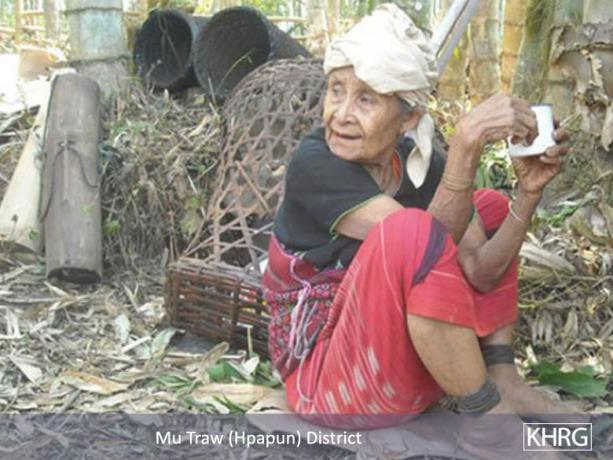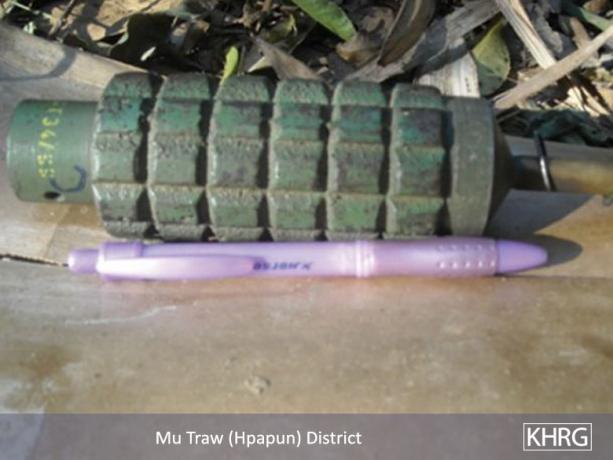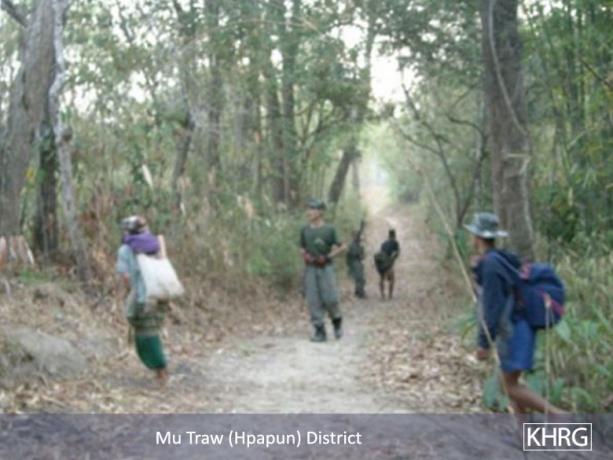This report describes physical threats and food insecurity faced by internally displaced person hiding sites in Lu Thaw Township, Papun District as a result of SPDC operations, and the rape of a 13-year-old girl by an SPDC soldier in Dweh Loh Township. This report examines cases of SPDC abuse from December 2008 to March 2009.
In late 2005/early 2006, the State Peace and Development Council (SPDC, Burma's ruling junta) began an intensive military offensive in much of Northern Karen State, including Toungoo, Nyaunglebin and Papun Districts. During the offensive, many villagers fled to internally displaced persons (IDP) hiding sites where they could avoid living under SPDC control. These displaced communities have been directly targeted by SPDC soldiers and face many difficulties. One example of the pervasive nature of SPDC abuses against displaced villagers can be found in Lu Thaw Township, Papun District. If Lu Thaw villagers in hiding are found by SPDC troops, they risk being be shot on sight. If their hillside farm fields and food stores are found, the SPDC often burns them down in attempt to drive the villagers into SPDC-controlled areas.
Over the course of the offensive, the SPDC has militarized large swaths of Northern Karen State and, in Lu Thaw Township alone, increased the total number of SPDC Army camps to 46. Although the SPDC Army has withdrawn from 13 of these camps since late 2008, villagers in Lu Thaw still face insecurity in a variety of ways, including a severe food shortage caused by SPDC abuses. SPDC soldiers still based in Lu Thaw Township continue to actively patrol near IDP hiding sites and thereby prevent villagers from accessing both their farm fields and the markets in which they can sell their harvested crops.[1]
Insecurity and the food crisis
When patrolling near IDP hiding sites, SPDC troops often fire mortar rounds into villagers' fields or farms in order to destroy these villagers' livelihood resources. As a result, many villagers are afraid to work in their farms and fields. This situation consequently leads to food shortages and health problems among villagers. Moreover, SPDC soldiers often plant landmines around these farms and fields in order to prevent villagers from returning-this is done in order to pressure displaced villagers into moving into SPDC-controlled villages. Those hiding villagers who do decide to return to their lands during harvest periods or to collect hidden food are often injured or killed by landmines when they arrive home.
In one example, SPDC troops from Light Infantry Battalion (LIB) #589, led by Commander Htun Sein, actively patrolled the area around Htee Moo Kee village for over a year from December 3rd 2007 to December 2008. These troops based their camp in an area that was an hour's walk from several displaced hiding sites. Those villagers in hiding were forced to be very cautious in their movements and had to make sure to establish the locations of SPDC patrols before they attempted to enter their hill fields. During this period, the SPDC typically fired at least ten mortar rounds from their camp into villagers' hill fields each week. In December 2008, LIB #589 abandoned their main camp in Bpwa Gkaw, finally allowing villagers to return home to collect or harvest their food. On their way back to their old village, a young woman stepped on landmine planted by the SPDC and injured her left leg. She was sent to nearby Bp--- clinic and then was sent ahead to another clinic in D---, Papun District. She began receiving treatment in December and began recovering from her injury in January 2009.
In another example, villagers from Yeh Muh Bplaw, Plah Koh, Saw Muh Bplaw, Ler Muh Bplaw Nah Yo Hta and Kay Bpoo village tracts have had to flee their homes and move from place to place in order to avoid SPDC troop movements. However, starting in late 2008, the Burma Army began decreasing the frequency and extent of its patrols in northern Papun District and so, to some extent, villagers have had the opportunity to search for suitable farmland. However, they have not found any arable land for their crops and are still too afraid of SPDC patrols to permanently return to their original villages.
Another problem is that more and more displaced villagers from other villages come to live at IDP hiding sites, increasing the population of a given site and decreasing the amount of land available for farming. Such impediments to farming have exacerbated food shortages for these displaced villagers. Despite the strains caused by such population increases, there are also benefits of having new arrivals at hiding site as new villagers can share information about SPDC troop movements and may bring with them additional supplies.
Rape and sexual violence
While not as frequent as other forms of abuse, KHRG researchers continue to document cases of sexual violence committed by military forces with impunity against residents of rural Karen State.[3] In a recent example, on February 27th 2009, a soldier from SPDC LIB #---, under Light Infantry Division (LID) #11, raped Naw M---, a 13-year-old girl from W--- village, Papun District. Naw M--- was raped while she was travelling to collect water from a nearby river. After the rape occurred, SPDC Company Commander Y--- worried that other villagers would find out about the incident and so gave 40,000 kyat to the victim's parents-the parents were instructed not to discuss the case with anyone. Even though the girl's parents were not at all satisfied by the commander's bribe, they were too afraid of the soldiers to refuse the money.
It is evident in this and other reports on Karen State that perpetrators of sexual violence often go unpunished by their superiors. This culture of impunity is enjoyed by soldiers within the different ranks of the SPDC army and hinders the prevention of future rape cases in the region. Such acts of rape and sexual violence, furthermore, serve to support the structures of SPDC military power and to further subjugate residents of Papun District.
Conclusion
The fact that many Karen State villagers have decided to live in hiding rather than under SPDC control demonstrates that these individuals are not passive victims of abuse. Rather, they have consciously decided to leave their homes and have actively employed a variety of strategies to mitigate the abuses committed against them. The international community, in order to better address the situation of generalized violence in Karen State, needs to recognize and tangibly support the strategies that these individuals are already using to maintain their lives outside of abusive SPDC rule.
These pictures were taken on March 1st 2009. The two children in the left photograph are playing in T---village, an IDP hiding site in Papun District, while their parents build a new shelter for their family. An elderly women shown in the right photograph is drinking water under a bamboo stand in T--- village. Due to ongoing Burma Army attacks, children do not have a chance to study and it is very difficult for elderly people to flee SPDC advances by themselves. [Photos: KHRG]
The two photographs above were taken on March 5th 2009 and show MM-1 type landmines laid by LIB #242-a unit led by Deputy Commander Min Htun and included under Military Operations Command (MOC) #16. The MM-1 is a domestically manufactured Burmese variant of the Chinese Type 59 stake-mounted fragmentation mine.[2] These landmines were removed by Karen National Liberation Army (KNLA) troops on December 24th 2008. The SPDC Army had laid these landmines in Pla Koh village tract, Lu Thaw Township. The picture on the bottom left shows villagers crossing T---- vehicle road- which is situated in Lu Thaw Township-while being guarded by KNLA soldiers. [Photos: KHRG]
This picture was taken on March 10th, 2009 and shows the displaced residents of B--- village, Lu Thaw Township taking a short rest while cutting down trees in order to clear space for a new hill field. [Photo: KHRG]
This picture was taken on March 1st 2009 and shows a farm situated in T--- village, Lu Thaw Township. This farm has been abandoned since early 2006 at the beginning of the Northern Karen State offensive. This is ideal land for planting rice paddy, but SPDC patrols have prevented villagers from cultivating it. [Photo: KHRG]
Footnotes:
[1] For more information about attacks on displaced villagers and the resulting food crisis, see Attacks, killings and the food crisis in Papun District, KHRG, February 2009.
[2] Landmine Monitor 2008: Burma/Myanmar, International Campaign to Ban Landmines, 2008.
[3] For examples of past rape cases and attempted rape cases in Karen State, see Forced Labour, Extortion and Abuses in Papun District, KHRG, July 2006, and Attempted rapes and other abuses in northern Karen Districts, KHRG, March 2006.



















